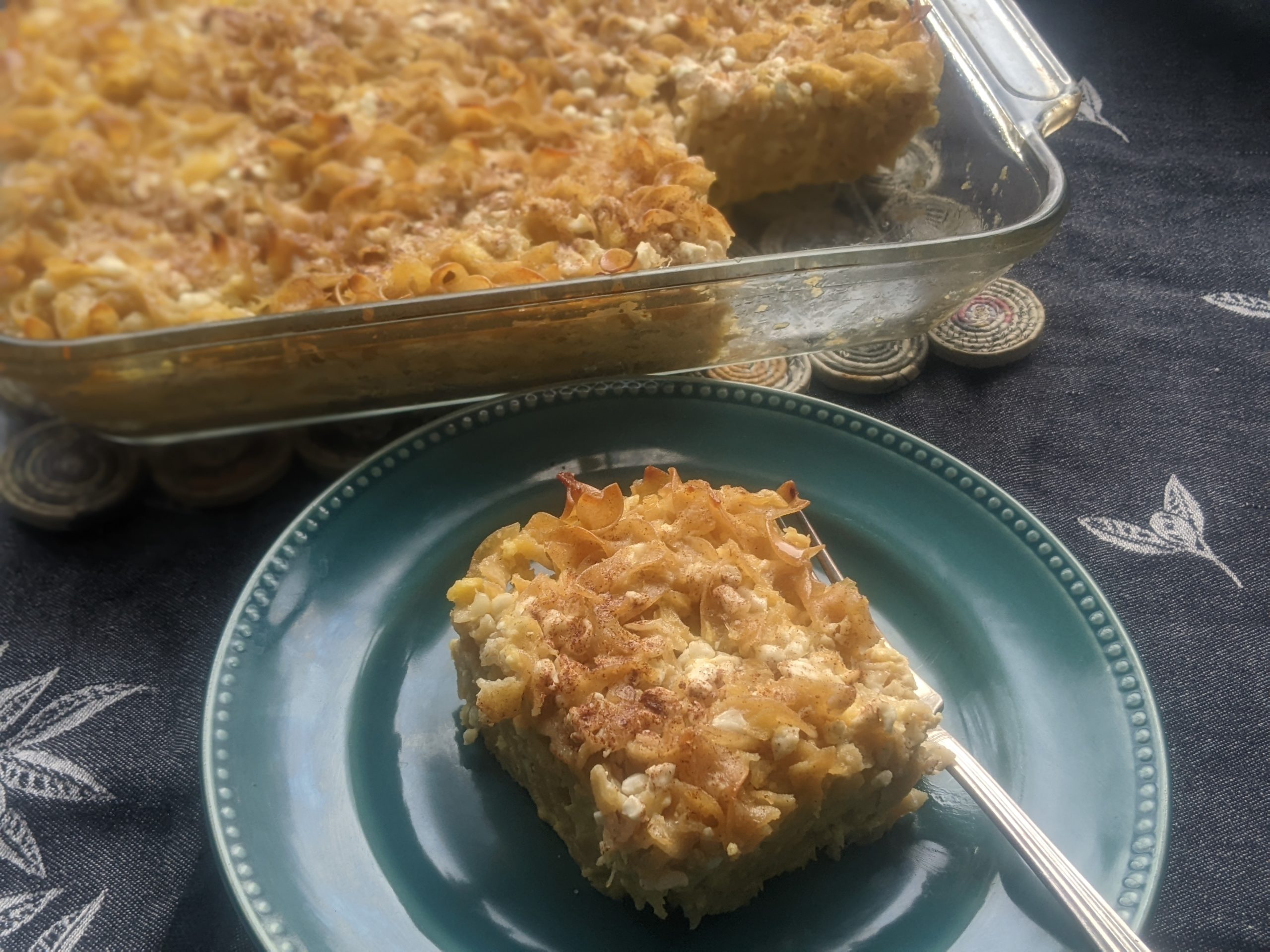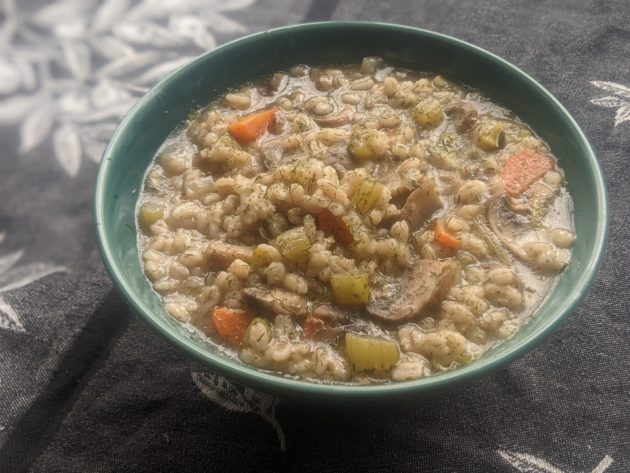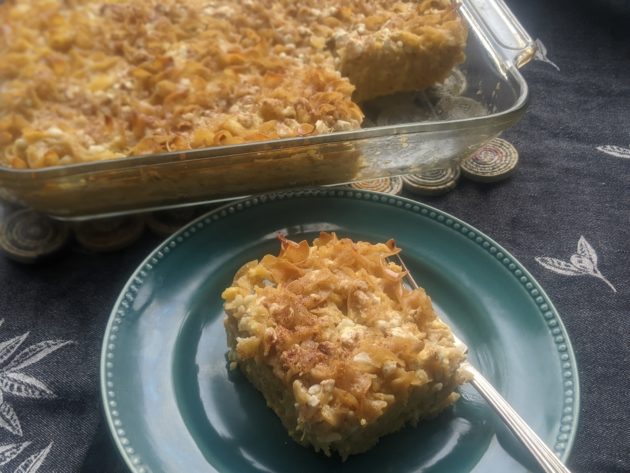
A Hug of Comfort Food
What is it about certain foods that bring us comfort, soothe us even if just for a few minutes? How do certain foods give us an opportunity to step back from what is stressing or hurting us, to feel nourished somehow in body and spirit?
Comfort food lives in our memories, sparked by nostalgia and sentimental feelings. For each of us, our comfort food is connected to people, places, events and experiences in our lives. It’s the food we grew up with or had at special times, whether that was buttered challah at every Shabbat dinner or mac n’ cheese we ate every time we went to our best friend’s house growing up. It doesn’t even matter if the food was homemade or came from a bag or a box.
If ever there was a time for comfort food, it’s now. We’ve been dealing with the pandemic for nearly two years. Social isolation, disrupted holidays and special life events, uncertainty about work and health, too much loss. On top of that, it’s February, the seemingly longest month of the year for many of us in colder climates. Clearly, we can all definitely use some comfort food!
Are you a bagel-brisket-babka person or do you find comfort in burekas, bumuelos and baklava?
In the current Winter Issue of Lilith, I have a short story focusing on the healing powers of soup, including a favorite recipe for soul-warming Chickpea and Greens Soup. In reality, that essay barely scratched the surface of what I have to say about the topic. Yes, as I said in that story, comfort food is personal. But what else makes comfort food?
What is comforting to each of us has been influenced by family and cultural traditions. Are you a bagel-brisket-babka person or do you find comfort in burekas, bumuelos and baklava? Perhaps you’re the product of a Sephardic-Ashkenazic marriage, as I am, so all of the above might bring you solace! I find comfort in the chickpea soup of my father and chicken soup of my mother.
Comfort food can be simple to make, like the noodles and cottage cheese or sour cream that comforted many of us as children. Our need for it is often situational—with us when we mourn or celebrate, in sickness and times of change, after a bad day at work or even sometimes a good day, and for homecomings whether it’s been years or days since we left. And not surprisingly, we need comfort food all year round because…well, life happens. A bowl of cold gazpacho or some juicy watermelon with lots of fresh lime, as my father ate it, provide perfect summer comfort for me.
Sure, some comfort food can be full of fat and carbohydrates as too many food stories and recipes tout, but much of it is not. Think of all the soups, the roast chickens or briskets, the vegetable tagines, the carrot rings…in college, a cup of Constant Comment tea, my favorite for years growing up, took me home again across nearly 1,800 miles. These days, with the temperature in DC still dipping below freezing, sometimes the most comforting thing I can eat is a big, crispy salad with lots of fresh veggies and crunch. Perhaps it’s because it fills me with hope of warmer, and healthier, days ahead for all of us.
On February 13, my latest Lilith cooking classes on Zoom focused on comfort food. Below are recipes for just a few of my personal favorites we made in class. It’s my way of sharing hugs of comfort with all of you.
Mushroom Barley Soup

This is one of those classic comfort foods found in nearly every Jewish deli, but it’s actually easy to make for yourself. Traditionally made with broth from beef bones, the soup is also good with vegetable, chicken or mushroom broth, so use what works for you.
Barley is an ancient and fiber-rich grain with good amounts of vitamins, minerals and antioxidants. There are different varieties of barley. This recipe is timed for pearled barley which is the most common sold in grocery stores. Although technically not a whole grain as the hull has been removed, it’s healthier than most other refined grains because some of barley’s fiber remains in the kernel. There are also quick cooking and hulled barley, which takes about 30 to 40 minutes more to cook, so be sure to read package directions. Although the recipe says to dice the vegetables, chop or dice to the size you like. If you make them a bit chunkier and use only 7 cups of broth, it becomes more of a lovely thick stew.
Ingredients:
- 2 tablespoons olive oil
- 1 large yellow or white onion, diced (about 1 cup)
- 2 medium carrots, diced, peeled or unpeeled (about 1 cup)
- 2 celery stalks with leaves, stalks (about 1 cup) and leaves diced separately
- A few pinches plus 1 teaspoon salt
- 2-3 medium cloves garlic, minced, grated or crushed through a press
- 1-1 1/4 pound white button or cremini mushrooms, sliced on the thin side
- 1 cup uncooked pearl barley
- 1 teaspoon dried thyme
- 2 teaspoons dried dill
- 8-9 cups vegetable, chicken, beef or mushroom broth
- 1/4-1/2 teaspoon pepper
Heat the olive oil in a large soup pot, preferably heavy bottomed, over medium heat. Add the onion, carrots, celery and a couple pinches of salt. Cook for about 10 minutes, stirring occasionally, until starting to soften. Add the garlic and cook for another minute. Stir in mushrooms and cook for about 10 to 12 minutes, stirring occasionally as the vegetable soften.
Add barley, thyme, dill and 8 cups broth. Stir well and bring to a boil. Cover, turn the heat to medium low or low and let the soup simmer gently, stirring occasionally, for about 50 minutes until the vegetables and barley are soft and the flavors have blended. Season with salt and pepper to taste. Add the extra cup of broth as the soup cooks and thickens to get your desired consistency.
Serve hot. Cool completely before storing in the refrigerator for up to 5 days or freezer for up to 3 months.
Shirley’s Easiest Noodle Kugel

This is my mother’s amazingly easy recipe that I have been making and eating for many years. The trick is you don’t cook the noodles first! I have made a few small changes to make it a bit healthier, like cutting the sugar in half and using whole wheat noodles and low-fat or non-fat dairy ingredients. You can also reduce the butter to 3/4 of a stick or 6 tablespoons. If not using cottage cheese, add an additional 1/2 cup sour cream or yogurt. If you can’t find crushed pineapple, buy a small can of chunks and pulse it in the blender with the juice until it’s in very small pieces. The pineapple with its juice adds great flavor to the kugel, but if you don’t use it, use an additional 1/2 cup milk or milk alternative. All the liquids and wet ingredients hydrate the noodles as the kugel bakes. For an OMG dessert, top a piece of warm kugel with a scoop of ice cream, especially cinnamon. You will never view kugel the same again!
Ingredients:
- 1 stick (1/4 pound) butter or butter substitute
- 4 large eggs
- 1/2 cup sugar
- 1/2 teaspoon salt
- 2 cup milk or unsweetened milk alternative (oat, soy, almond, hemp, rice)
- 1/2 cup sour cream or plain yogurt
- 1 teaspoon vanilla
- 1 teaspoon ground cinnamon
- 1 cup (8 ounces) small-curd cottage cheese or
- 1 8-ounce can crushed pineapple, including juice
- 1 12-ounce package wide egg or whole wheat noodles
- Ground cinnamon (optional)
Preheat oven to 350 degrees.
Put the butter in a glass 9×13-inch pan and place it in the oven while you mix up the ingredients. When it’s melted, after about 8 or 10 minutes, take out the dish and turn the pan around it to make sure the butter has spread over the entire bottom and part way up the sides of the pan. Leave the extra butter in the pan.
In a bowl, beat the eggs, then whisk in the sugar, salt, milk, sour cream or yogurt, vanilla and cinnamon until well blended. Add cottage cheese and crushed pineapple with juice, stirring well. Add apples or dried fruit if using
Spread uncooked noodles in the buttered pan. Pour or ladle the liquid mixture evenly over the noodles and pat down the top gently to make as even as possible. Sprinkle the top with extra cinnamon if desired.
Cover the pan loosely with aluminum foil and bake for 45 minutes. Remove foil and bake about 15 minutes more or until golden brown and crispy on top. Serve immediately or cool and refrigerate for up to 5 days. The kugel freezes well, either whole or cut into smaller portions. Reheat covered, mostly or fully defrosted, in 350-degree oven for 10 to 15 minutes. Open the oil and heat 5 to 10 minutes more to crisp the top.
Savory Spinach Noodle Kugel
This savory noodle kugel is a long-time favorite in Jewish homes where it would be made pareve with Lipton’s Onion Soup mix and Dairy Rich for decades before the explosion of milk alternatives in the 2000s. If milk is used, it can be full- or low-fat. It’s one of my go-to dishes for new moms, with whole wheat noodles and often a cup of cottage cheese mixed in for extra nutrition.
Ingredients:
- 1 12-ounce bag medium egg or whole wheat noodles
- 4 large eggs
- 1/4 cup good vegetable oil (safflower, avocado, grape seed, sunflower)
- 2 cups milk or unflavored, unsweetened milk alternative (such as rice, soy, hemp, oat)
- 2 teaspoons onion powder
- 1/2 teaspoon garlic powder
- 1 teaspoon salt
- 1/2 teaspoon pepper
- 1/8 teaspoon of nutmeg
- 1 16-ounce bag chopped spinach, defrosted
Preheat oven to 350 degrees. Use spray oil to grease well a 9×13-inch inch baking dish. Spread the uncooked noodles out evenly in the baking dish.
In a large bowl, use a whisk to beat the eggs well. Add the oil, milk or milk alternative, onion powder, garlic powder, salt, pepper and nutmeg. Mix well. Add the defrosted spinach including all the liquid in the bag and mix with a large spoon until everything is well incorporated.
Pour the mixture evenly over the noodles in the greased baking dish. Carefully stir a bit to make sure the spinach is mixed evenly with the noodles. Cover tightly with aluminum foil and bake for 45 minutes. Take off the aluminum and continue baking uncovered for 10-15 minutes more to brown and crisp the top.
Serve immediately or cool and refrigerate for up to 5 days. The kugel freezes well, either whole or cut into smaller portions. Reheat covered, mostly or fully defrosted, in 350-degree oven for 10 to 15 minutes. Open the oil and heat 5 to 10 minutes more to crisp the top.
Sutlach (Rice Pudding)

This Turkish-style rice pudding, sütlaҫ in Turkish, is served throughout the Mediterranean and Mid East and beloved by Sephardim. Many of the older generation fondly remember mothers or grandmothers sprinkling cinnamon in the shape of each child’s initials on the top of individual servings. Made with rice flour, it’s a quick way to have a creamy, comforting pudding. Sutlach was traditionally prepared the day before to be served for Shabbat morning breakfast and to break the fast after Yom Kippur. Sometimes instead of milk, the fast-breaking pudding was made even more restorative by using pipitada, a drink made by steeping dried and ground melon seeds in water for 24 hours. Flavor the pudding to your liking including one or both the vanilla and orange zest, or omit both and use instead 1 to 2 teaspoons of rose water for a Persian-accented flavor.
Makes about 6 servings.
Ingredients:
- 1/2 cup rice flour*
- 1/2 cup sugar
- About 1/3 cup water
- 4 cups milk or milk substitute
- 1 teaspoon vanilla extract
- 1 tablespoon grated orange zest (optional)
- Ground cinnamon
In a medium bowl, whisk together the rice flour and sugar. Whisking constantly, slowly add just enough water to form a thick, smooth paste.
In a saucepan over medium heat, bring the milk just to boiling point when you can see little bubbles starting to form around the edge, but do not let boil. To keep lumps from forming, stir with a wooden spoon or whisk constantly as you slowly and steadily add the rice-flour paste to the milk. Keep stirring constantly until it thickens, about 10 minutes. Lower the heat if needed to keep the mixture from boiling.
Remove from the heat and stir in the vanilla and orange zest or rose water. Pour into custard cups or small bowls for individual servings. Sprinkle with cinnamon, especially in initials, Hebrew letters or other design. Let cool on the counter and serve at room temperature or refrigerate until chilled. Keep refrigerated and serve within two days.
*Traditionally made with white rice flour, sutlach can be made with brown rice flour, resulting in more of a light tan color.
All recipes property of Susan Barocas. Please share only with credit and do not reprint without permission.



